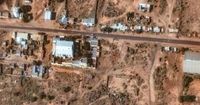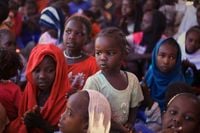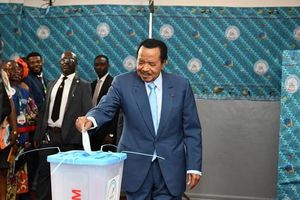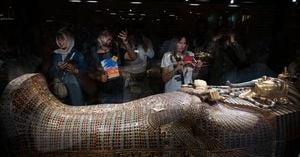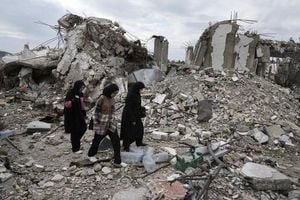Fresh satellite images have cast a devastating new light on the violence engulfing Sudan’s Darfur region, revealing what analysts and humanitarian groups say are mass graves in the city of El Fasher following its capture by the paramilitary Rapid Support Forces (RSF). The images, reviewed by multiple independent experts and news agencies, point to large-scale burials at sites closely tied to recent atrocities, stoking fears that the true scale of the conflict’s toll may never be fully known.
According to the Yale School of Public Health’s Humanitarian Research Lab, which analyzed high-resolution images from Colorado-based satellite firm Vantor, two main suspected mass grave sites have emerged: one beside a mosque north of the Saudi Hospital, and another adjacent to a former children’s hospital, now reportedly used as an RSF detention center. The Associated Press confirmed the findings with its own review of Vantor and Planet Labs imagery, noting distinct color changes in the soil—an indicator of recent digging and reburial at both locations.
“It is not possible based on the dimensions of a potential mass grave to indicate the number of bodies that may be interred; this is because those conducting body disposal often layer bodies on top of each other,” the Yale lab stated in its report, as cited by The Associated Press. This chilling detail underscores the difficulty of estimating the true number of victims, especially as evidence may be deliberately concealed or destroyed.
Earlier satellite images, captured soon after the RSF’s seizure of El Fasher, showed white objects and visible blood stains scattered near the Saudi Hospital and the children’s hospital. The Yale team identified these as likely human remains. Testimonies from survivors, online videos, and field reports have described RSF fighters executing civilians and medical personnel—accounts that paint a grim picture of the aftermath of the city’s fall.
One particularly harrowing case was the killing of Dr. Adam Ibrahim Ismail, a local physician reportedly detained and shot dead by RSF fighters during their incursion into El Fasher. The Sudan Doctors’ Network condemned his death, calling it part of a deliberate campaign targeting healthcare workers. “It was a heinous crime targeting doctors and aid workers,” the group said, as reported by multiple outlets.
The RSF, for its part, has denied responsibility for killings at the Saudi Hospital. However, their own videos from inside El Fasher—released amid mounting international condemnation—have been carefully edited, confirming recognizable hospital structures but pointedly omitting scenes that social media videos and satellite images suggest show fighters moving among bodies or executing survivors. The Associated Press noted that the RSF’s footage avoided areas where bodies had previously been visible, further fueling suspicions of evidence tampering.
Outside the city, additional Planet Labs imagery from late October depicted white shapes—again, likely corpses—along a northern berm and near burned-out vehicles, corresponding to footage of RSF fighters moving through the area and firing at wounded individuals. Analysts from Yale and the AP observed that some bodies from this attack appeared to have been removed in subsequent images, suggesting attempts to conceal the extent of the violence.
As the RSF consolidates its grip on El Fasher, the ability of independent investigators to document potential war crimes grows increasingly limited. United Nations Secretary-General António Guterres has called for “mechanisms of accountability” to investigate what he described as “horrendous crimes,” but human rights experts warn that with communications down and access severely restricted, much of the evidence may already be lost.
The siege of El Fasher took place in the context of a brutal civil war that has raged across Sudan since April 2023, pitting the RSF against the Sudanese Armed Forces. The World Health Organization reported that over 450 people were killed at the Saudi Hospital alone during the assault, including women and children. The Sudan Doctors’ Network went so far as to call the events in El Fasher a “true genocide.”
Yet the violence in El Fasher is only one part of a much wider humanitarian catastrophe. On November 4, a deadly drone strike hit a funeral in El Obeid, capital of North Kordofan province, killing at least 40 people and wounding dozens more. While the United Nations has not assigned blame for the attack, local media and observers have pointed to the RSF, which has increasingly relied on drone warfare in its offensives across Darfur and Kordofan.
The fighting has had a devastating impact on Sudan’s civilian population. According to United Nations estimates, more than 40,000 people have been killed since the conflict began, though aid groups warn the true toll could be far higher. Over 14 million people have been displaced, many forced to flee repeated waves of violence, and entire regions are now facing famine and disease outbreaks as humanitarian access remains blocked.
Ross Smith, the World Food Program’s director of emergency response, described the dire situation facing many Sudanese families: “We’re seeing very poor food consumption, with families going days without meals,” he told reporters this week. “We have many reports of mortality. This is related to conflict for sure.”
The roots of Sudan’s current crisis can be traced back to the collapse of the uneasy alliance between the RSF and the central government following the country’s 2019 transition of power. What began as a political dispute quickly spiraled into open warfare, with both sides accused of grave abuses against civilians. El Fasher, the last government stronghold in Darfur, became a focal point for the struggle, and its fall marks a significant turning point in the conflict.
Ethnically targeted killings, widespread sexual violence, and the systematic destruction of civilian infrastructure have all been reported in the wake of the RSF’s advance. The Sudan Doctors’ Network and other humanitarian organizations have called for urgent international intervention, warning that the window to prevent even greater loss of life is rapidly closing.
With satellite imagery now providing some of the only independent evidence of atrocities on the ground, the world’s attention is once again fixed on Darfur—a region already scarred by decades of conflict and impunity. As mass burials continue and survivors struggle to be heard, the question remains whether the international community will find a way to hold those responsible to account and stem the tide of suffering.
The story of El Fasher is, tragically, not unique in today’s Sudan. But as new evidence emerges from above, the reality of the crisis is impossible to ignore.
